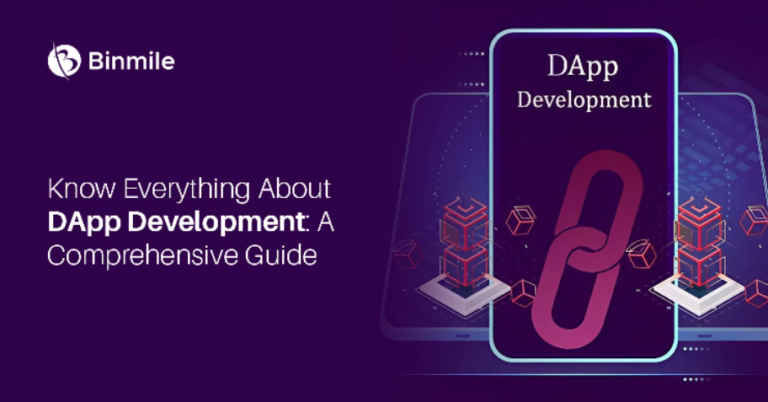Decentralized applications, commonly referred to as DApps, have gained significant attention in recent years due to their potential to revolutionize various industries. In this beginner’s guide, we will explore the fundamental concepts of DApp development, shedding light on what they are, how they work, and the essential components involved. Let’s dive in!
What is a DApp?
A DApp is a type of software application that runs on a decentralized network, typically leveraging blockchain technology. Unlike traditional applications, DApps are not controlled by a single entity, offering greater transparency, security, and resilience against censorship.
How Do DApps Work?
Architecture
DApps are built on top of blockchain platforms like Ethereum, which provide the underlying infrastructure for decentralized computing. They consist of smart contracts, which are self-executing agreements coded onto the blockchain, and a user interface (UI) that interacts with the smart contracts.
Key Components of DApp Development
Smart Contracts
Smart contracts form the backbone of DApp development, governing the rules and logic of the application. They are written in programming languages like Solidity and are deployed on the blockchain, where they autonomously execute predefined actions when triggered by specific conditions.
User Interface (UI)
The UI of a DApp is what users interact with to access its features and functionalities. It can be a web-based interface, a mobile application, or even a command-line interface (CLI). The UI communicates with the smart contracts on the blockchain, enabling users to perform various actions seamlessly.
Blockchain Integration
DApps rely on blockchain technology for data storage, security, and consensus mechanisms. Blockchain integration ensures that the application operates in a trustless environment, where transactions are transparent, immutable, and tamper-proof.
Decentralized Storage
To store data securely, DApps often utilize decentralized storage solutions like IPFS (InterPlanetary File System) or Swarm. These technologies enable data to be distributed across multiple nodes on the network, reducing the risk of data loss or manipulation.
Tokenization
Many DApps incorporate tokens or cryptocurrencies as a means of incentivizing user participation and facilitating transactions within the ecosystem. Tokens can represent various assets, such as digital collectibles, utility credits, or governance rights, depending on the DApp’s use case.
Benefits of DApp Development
Transparency and Immutability
One of the primary advantages of DApps is their transparency and immutability. Since they operate on a blockchain, all transactions and interactions are recorded on a public ledger, providing a transparent audit trail that cannot be altered or manipulated.
Security and Trustlessness
DApps leverage cryptographic techniques and decentralized consensus mechanisms to ensure security and trustlessness. By eliminating single points of failure and central control, DApps are inherently more resistant to hacking, censorship, and unauthorized access.
Decentralization and Resilience
Decentralization is a core principle of DApp development, enabling applications to operate without relying on a central authority. This decentralized architecture enhances the resilience of DApps, making them less susceptible to downtime, censorship, or regulatory interference.
Challenges and Considerations
Scalability
Scalability remains a significant challenge for DApp development, especially for platforms like Ethereum that have faced congestion and high transaction fees during periods of heavy usage. Solutions like layer 2 scaling and sharding are being explored to address scalability issues.
User Adoption
Achieving widespread user adoption is another challenge for DApp developers, as many users are still unfamiliar with blockchain technology and cryptocurrencies. Improving the user experience, educating users, and offering compelling incentives can help drive adoption.
Conclusion
DApp development signifies a revolutionary change in software development practices, presenting a decentralized approach compared to conventional applications. Understanding the core principles of DApp development is pivotal for developers, as it opens doors to novel avenues of innovation, paving the way for the creation of applications characterized by enhanced transparency, security, and resilience. Embracing these principles enables developers, including those in the mobile app development company sector, to harness the full potential of decentralized applications and contribute to the evolution of the digital landscape.
Frequently Asked Questions
1. What is a DApp?
A DApp, short for decentralized application, is a type of software application that operates on a decentralized network rather than a centralized server. It leverages blockchain technology to enable peer-to-peer interactions and transactions without the need for intermediaries.
2. What are smart contracts?
Smart contracts are self-executing contracts with the terms of the agreement directly written into code. They automatically execute and enforce the terms of the agreement when predefined conditions are met, without the need for intermediaries.
3. How do DApps differ from traditional applications?
Unlike traditional applications, which rely on centralized servers and databases, DApps operate on decentralized networks like blockchain. This decentralization ensures greater transparency, security, and resilience against censorship.
4. What are the benefits of using DApps?
DApps offer several benefits, including transparency, security, decentralization, and resilience. They provide users with greater control over their data and assets, reduce the risk of fraud and censorship, and enable new forms of peer-to-peer interaction and collaboration.
5. What are some examples of popular DApps?
Some popular examples of DApps include decentralized finance (DeFi) platforms like Uniswap and Compound, decentralized social media platforms like Steemit and Minds, and decentralized gaming platforms like Axie Infinity and CryptoKitties.





